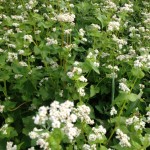It always feels like July 4th is the peak of summer and when those hot summer days seem to kick off. In fact the longest day of the year is the summer solstice which falls in late June, and the days gradually get shorter from there. Many long day flowering plants will flower or “bolt” around this time. One that I saw most recently was lettuce. Lettuce is a long day plant that when exposed to darkness for periods of eleven hours or less will flower or bolt. Unfortunately lettuce was never bred for its flower and the bolting causes chemical changes in the plant and it is accompanied by a bitter taste in the leaves. I know that read kind of funny. Even though the plant is called a “long day plant” the transition to flowering is dictated by the shortened period of darkness that comes with the longer days. So that’s how the long day plants work, they need eleven hours of darkness or less. So when the days become thirteen hours or longer these plants will start flowering due to the shortened dark periods.
Weeds are also tied to the day lengths and temperatures to transition to flower. There is a reason why allergies fall at certain times of the year. As stated earlier some long day plants are flowering now. One of these examples is the Giant Ragweed.
 Giant Ragweed is a summer annual that can grow up to seven feet tall or greater. Giant ragweed is a monoecious plant, much like corn. Giant Ragweed produces separate male and female flowers on the same plant. It flowers in racemes that hold a cluster of small flowers. The male flowers that produce pollen are on top while the female flowers are located at the base of the raceme. This is a strategy that many monoecious plants take. Corn tassels are also the male flowers which are located on top to increase the chances of pollination.
Giant Ragweed is a summer annual that can grow up to seven feet tall or greater. Giant ragweed is a monoecious plant, much like corn. Giant Ragweed produces separate male and female flowers on the same plant. It flowers in racemes that hold a cluster of small flowers. The male flowers that produce pollen are on top while the female flowers are located at the base of the raceme. This is a strategy that many monoecious plants take. Corn tassels are also the male flowers which are located on top to increase the chances of pollination.
Common Burdock is another weed that is flowering now. 
The Burdock flower looks a lot like the thistle flower but the plant has a very large broad leaves at the base. The leaves can grow to be almost 2 feet long and can be over a foot wide. When this flower is fertilized it produces a bur type fruit that will attach to clothes and hair.
Wild carrot is also flowering at this time; this plant is sometimes known as Queen Anne’s lace.

The flowers are white and set up as an umbel. An umbel is a cluster of flowers that have a single attachment point. It produces a round flat cluster of flowers that are known to attract butterflies. I have heard it being referred to as a “helicopter pad” for butterflies…
One of the best ways to identify plants is to do it during flowering times. When a plant flowers will give you a lot of information as to its identity, and many plant keys will require the flower to be utilized in its identification.







